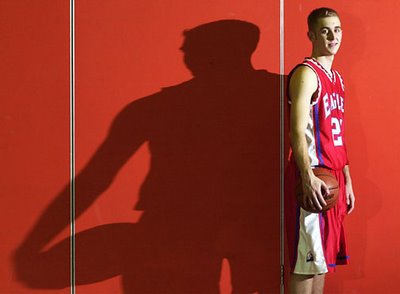 When most of us started out using flash, we did it primarily to increase the quantity of light.
When most of us started out using flash, we did it primarily to increase the quantity of light. But the quality of the light really stunk. So we started looking at work from other photographers, who used things like bounce, umbrellas, soft boxes, etc., to change the quality of the light. And we began to think, "Hard light bad, soft light good."
Those bad early experiences, I suspect, have built into many of us a bias against hard light. Which is really a shame.
There is nothing inherently wrong with hard light at all. The problems with our bad early experiences were largely the result of bad light direction (as in "on camera") and truly horrid lighting ratios (as in "nuke 'em 'till they glow.")
But if you approach hard light with an eye toward light direction, light color and lighting ratio, hard light can really work for you. Which is a good thing for small strobe users, because these units really do have a lot of power to give if you are not diffusing it away.
And hard light - especially from multiple angles - has a crisp, high-end (if you mind your ratios and fill) look that reproduces well even when printed on
Soft light may be safer, more predictable light. But, the way I see it, the little TFT displays on the back of our Nikons and Canons give us the feedback we need to live out on the edge a little when it comes to light.
If you want to dip your toe in the water, try working close to the ambient level. (If you do not know what I mean, you will learn how to do this a couple of posts down from here.) The fact that the shadows will have good detail will lessen the chances of getting a bad result with hard light. But the edgy effect will still be there.
You can easily create your own soft light/hard light combinations by using two small strobes, too.
Say you had an environmental portrait in an office. You might bounce one small strobe off of the ceiling, softly bringing the room up to, say, f/4. Then you put your other strobe on a stand, point it directly at your subject's face, and dial it down until it gives you an exposure of about f/5.6. You may wish to limit the area the hard light will hit by moving the flash up close and zooming the head to an 85mm coverage angle. Or use a quickie snoot made out of a piece of cardboard.
So, you'd be shooting at f/5.6, with the shadows lit to f/4. The effect will be crisp light on the face of your subject, with nice shadow detail everywhere. Brownie points for thinking to cool the bounced strobe down a little (with a cooling gel) and warming up the harder accent light. (You'd then have contrast in color, direction and hard/soft quality of the two lights.)
Of course, you can just as easily get this effect with just one strobe and some ambient light floating around. Which is what we will talk about next.
Next: Balancing Flash Intensity with Ambient
No comments:
Post a Comment